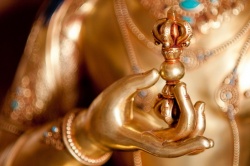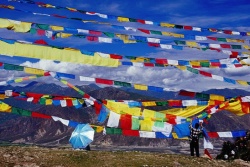Newar Buddhism
Newar Buddhism is the form of Mahayana-Vajrayana Buddhism practiced by the Newar community of the Kathmandu Valley in Nepal. It has developed unique socio-religious elements, which include a non-monastic Buddhist society based on a caste system and patrilineal descent. The ritual priests (guruju), Bajracharya or Vajracharya (who perform rituals for others) and Shakya or Banre (who perform rituals mostly for their own families) form the non-celibate religious sangha while other Buddhist Newar castes like the Urāy act as patrons. Uray also patronise Tibetan, Theravada, and Japanese Buddhist clerics.
Although there was a vibrant regional tradition of Buddhism in the Kathmandu Valley during the first millennium, the transformation into a distinctive cultural and linguistic form of Buddhism appears to have taken place in the fifteenth century, at about the same time that similar regional forms of Indic Buddhism such as those of Kashmir and Indonesia were on the wane. As a result, Newar Buddhism seems to preserve some aspects of Indian Buddhism that were not preserved in Buddhist schools elsewhere.
Newar Buddhism is a specific form of Vajrayana, different from Tibetan Buddhism, or tantric Japanese practices. Buddhism in the valley evolved from Hinayana and Mahayana to Vajrayana; at the end of the first millennium, and during the early part of the last millennium, Newar Buddhism became completely dominated by the Tantrayana teachings. In terms of social structure the society was dominated by the Hindu community. The impact of the bihas and the Buddhist devotees was such that monks got married and the monastic lineage and tradition died out, while the sangha became a patrilineal descent group. The biha became the hereditary property of a caste known as Bare or Shakyas. Some of their members take the initiation to become Vajracharyas, the Newar Buddhist priests.
The role of the permanently celibate monk or nun is open neither to the Shakyas and Vajracharyas nor to any other Newar. In the past those with a vocation for it joined the Tibetan monastic order. Nowadays there is also the increasingly popular option of Theravada Buddhism. But the traditional institutions of Newar Buddhism provide for no such role. Newar Buddhists are aware of this lack and their muth are apologetic about the absence of monks, ascribing this to forced laicization by the Hindu reformer, Shankara Acharya in the 14th century.
During the 17th century, Buddhism became very weak, and continued to wane. Nowadays, because of the sharp decline in scholasticism, Buddhist families go to the biha to ask the Vajracharya caste members to perform rituals such as ablution, recitation and so on, much in the same way as is done in Hinduism. Newar Buddhism takes on many of the forms of Hinduism. In the Golden Temple in Patan for example, Buddhists are asked not to walk through the main courtyard with leather shoes, as in many Hindu temples where one is not allowed to enter wearing leather, since cows are considered sacred.
Artistic tradition
Newar Buddhism is characterized by its extensive and detailed rituals, a rich artistic tradition of Buddhist monuments and artwork like the Chaitya (stupa), Baha and Bahi monastic courtyards, statues, Paubha scroll paintings and Mandala sand paintings, and by being a storehouse of ancient Sanskrit Buddhist texts, many of which are now only extant in Nepal.
According to the authors of Rebuilding Buddhism: The Theravada Movement in Twentieth-Century Nepal: "Today traditional Newar Buddhism is unquestionably in retreat before Theravada Buddhism." Chachā (Charyā) ritual song and dance and Gunla Bajan music are other artistic traditions of Newar Buddhism. Although Newar Buddhism was traditionally bound to the Kathmandu Valley and its environs, there is at least one new Newar Buddhist monastery in Portland, Oregon.
Outdoor festivals
A number of major street celebrations are held periodically involving processions, displays of Buddha images and services in the three cities of the Kathmandu Valley and in other parts of Nepal.
The main events are Samyak (almsgiving and display of Buddha images), Gunla (holy month marked by musical processions and display of Buddha images), Jana Baha Dyah Jatra (chariot procession in Kathmandu), Bunga Dyah Jatra (chariot processions in Lalitpur, Dolakha and Nala), and Bajrayogini Jatra (processions in Sankhu and Pharping).

